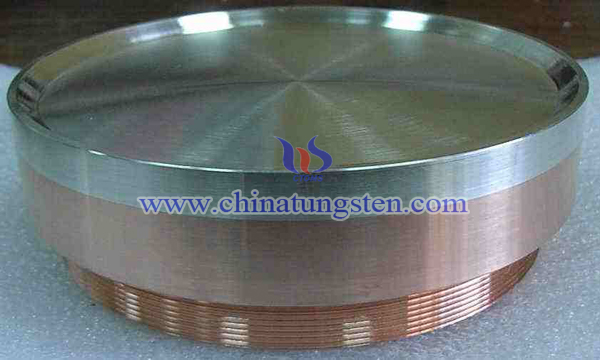Tungsten Target Back Plate Welding
- Details
- Category: Tungsten Information
- Published on Tuesday, 12 February 2019 21:57
In the semiconductor industry, the target assembly is composed of a target which meets the sputtering performance and a backplane which can be combined with the target and has a certain strength. The backplane can play a supporting role in assembling the target assembly to the sputtering base, and has the effect of conducting heat. For example, tungsten metal can be selected as target material, copper or copper alloy material with sufficient strength and high thermal conductivity can be selected as backplane to form target component.

During the sputtering process, the working environment of the target assembly is relatively harsh, and the ambient temperature of the target assembly is high, such as 300 to 600 ℃. In addition, one side of the target assembly is strongly cooled by cooling water, while the other side is in a high vacuum environment of 10_9Pa, which results in a huge pressure difference on the relative two sides of the target assembly; moreover, the target assembly is in a high voltage electric field. In the magnetic field, it is bombarded by various particles. In such a harsh environment, if the bonding strength between the target and the backplane is poor, the target assembly will deform, crack and fall off with the bonded backplane under heating conditions, which will make the sputtering unable to achieve uniform effect, and may also cause damage to the sputtering base.
When the target is close to physical properties such as the melting point of the back sheet, the target and the back sheet may be welded together using a conventional welding process such as welding, brazing to form a target assembly. However, in practice, for the target component composed of the tungsten target and the copper back plate, since the melting point of tungsten is 3417 ℃, the melting point of copper is 1084 ℃, the melting points of the two materials are different, and the existing fusion welding equipment It is not possible to achieve large-area butt welding, so it is not suitable for welding tungsten target and copper back plate by fusion welding; tin solder or indium solder used in brazing process has lower melting point (less than 250 ℃), so that when utilized When soldering a tungsten target to a copper backing plate, not only the bonding strength between the two is low (less than 70 MPa), but also the high temperature environment causes the solder to melt, which makes the sputtering process impossible.
Therefore, some enterprises adopt a self-made vacuum hot isostatic pressing process, by adding an intermediate layer between the tungsten target blank and the copper backing plate and using a hot isostatic pressing process to form the tungsten target blank having the intermediate layer, The copper back sheets are welded together to form a tungsten target assembly. This process can achieve large-area welding, and can prevent the surface of the solder material from being oxidized because the entire soldering process is performed under a vacuum environment;
In addition, the tungsten target material assembly has a high bonding ratio and bonding strength between the tungsten target material and the copper back plate, and the tungsten target material and the copper back plate are welded together and deformed little; the formed tungsten target component The use temperature can reach 600 ℃ or above, and the target component does not fall off under such high temperature conditions, and can break through various limitations of conventional fusion welding, brazing, and diffusion welding.
- Tungsten Manufacturer & Supplier, Chinatungsten Online: www.chinatungsten.com
- Tungsten News & Prices of China Tungsten Industry Association: www.ctia.com.cn
- Molybdenum News & Price: news.molybdenum.com.cn
- Tel.: 86 592 5129696; Fax: 86 592 5129797; Email: sales@chinatungsten.com



 sales@chinatungsten.com
sales@chinatungsten.com